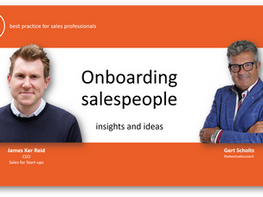
This sales tip is aimed at sales leaders who are planning sales for the period ahead. With the new year around the corner many sales leaders will be working their sales strategy for 2019. Here is a helpful template. Feel free to use it and pick what your want from it.
The Sales Strategy outlines the sales teams strategic plan of attack to penetrate the marketplace and generate revenue, focusing on the long-term framework of the sales approach. The Sales Strategy provides a foundation from which the Sales Plan can be produced, which covers the short-term tactical plan for engaging the customers and making the sales process more efficient. Both are heavily influenced by the company’s Growth Strategy and Market so have a copy on the ready.
Analysis and should be supported by a Marketing Plan that delivers qualified leads on a consistent basis. Where there is no lead generation, the Sales Strategy should fill this gap by through pro-active prospecting by the sales team.
Sales Strategy Components Include:
• Target Customer Profile
• Prospect Segmentation
• Sales / Distribution Model
• Sales Process Definition (i.e. Sales Cycle)
• Pricing Strategy
• Up-Sell Strategy
• Customer Training / Support Policy
Target Customer Profile.
The first step in a successful sales strategy and plan is to develop a clear understanding of who you are selling to and to communicate this to the entire sales team. The Target Customer Profile identifies the typical person (or persons) in the core market(s) the product / service is being sold. Often the person in the target organisation feeling the pain of not having your product / service (and therefore generating interest in the product) will not be the same person who has the decision-making power to approve the purchase, and this chain of key personnel should be identified in the Target Customer Profile. Going through this exercise will enable a sales team to tailor sales materials, sales processes, and overall sales strategy so they can be streamlined to more efficiently get “buy off” inside an organisation. Key components to be defined in a Target Customer Profile include target markets, market segments, and roles / position titles of all those likely to be involved in a purchase decision. Sales Strategy (continued)
Prospect Segmentation
Once the target customers have been identified and described, the next step is to segment the prospects so that they can most efficiently be approached by the sales team. Typically, this will involve market research in various industry directories to identify the top prospects in each market. Although it will vary from industry to industry, in general the prospects can be segmented on two criteria: Region and Quality. Generally, a regional territory will be assigned to a specific sales rep who may or may not be in that region. Prospects are further broken down into quality based on size of the company or the potential business opportunity the customer represents, which will allow sales reps to prioritise more lucrative prospects. As a rule of thumb, good sales plan should start with at least 100 prospects in each region (1000ʼs if possible), and the prospect lists will continue to grow as more market research is done.
Quality groupings for each prospect can vary considerably depending on the industry, but a simple and effective system is to designate three grading levels (A, B, C) with an
“A” prospect representing the most lucrative prospect,
“B” representing a mid-level prospect, and
“C” presenting all other prospects that are big enough to devote a significant sales effort. There should be a specific parameter that determines what quality grouping a prospect goes in such as annual revenue, marketing budget, number of employees, or some other industry standard ranking system but again, this will vary based on the industry and type of product / service offering. Designating quality will help the sales team prioritise resources, and to set sales goals such as a target number of A level prospects per quarter.
Sales / Distribution Model
The key to selecting and building an effective distribution channel is selecting a distribution model than best enables your sales team to and sustain a relationship with the target customer. The right choice of distribution model will be a function of Solution Complexity (how difficult the product is to install / deploy / use) and Marketing Complexity (how difficult the product is to source / buy / support). In general, this involves a decision about whether to use intermediaries to the sell the product, and how much “hand holding” a typical customer will need to make a purchase. Most industries already have prevailing distribution models, which will usually be the right choice from which to start. The chart to the right maps out different distribution model options based on the marketing and solution complexity criteria.
Sales process (a.k.a. “The Sales Funnel”)
The steps the sales team takes with each lead — from the initial contact with the prospect to the close of the sale and payment for goods. The goal of breaking down and defining the steps is to provide a framework for tracking sales and understanding the status of every sales prospect at any given point in time. It also helps to identify inefficiencies in the system so that sales managers can act to improve the conversion rates for each stage, resulting in a quicker Sales Cycle, more total sales and increased revenue. The Sales Process / Sales Cycle will be different for every industry, but typically will break down as follows:


Sales Funnel Calculation
The Sales Funnel Calculation is a mathematical model for estimating the number of “unqualified leads” that will be required to be brought into the sales cycle and converted into sales in order to reach a sales team’s revenue targets. It’s also a valuable tool for providing a benchmark for sales managers to gauge the success of their team’s performance. An unqualified lead is a cold lead — that is, a prospective customer that should reasonably be interested in the product but has not yet been contacted or otherwise indicated interest in the product. These leads become more “qualified” as they pass through each stage of the sales cycle until they finally turn into closed sales.
However, there will naturally be some percentage of attrition of these leads at each stage of the cycle. The trick is to estimate a reasonable amount of attrition at each stage, track the sales team performance, and then adjust these estimates for accuracy as more data on sales conversions become available. The ongoing objective is to take steps to continually improve the conversion rates for each stage of the sales cycle by continually refining the sales process.
Pricing Strategy
Pricing is one of the major elements of the “Marketing Mix” (along with Product, Place, and Promotion), and it is critical to positioning the product / service — both in minds of potential customers, and relative to the competition.
Determining the right price, a company’s range of products / services is an inexact science, and while there are several standard pricing models to consider, there are several factors related to any company’s specific situation that should be considered when formulating Pricing Strategy. See common factors affecting pricing strategy, and list of standard pricing models below:
Factors Affecting Pricing: In general, the goal for pricing products / services should be to price them as high as the market will bear, however this is not always a clear-cut decision, and there are several factors to consider that may make strategic adjustments to this theory critical to long-term success. Consider the following…
• Positioning: Does the company have enough perceivable product differentiation / competitive advantage to price higher than the competition, or will slightly under-cutting them in price be a faster way to build market share?
• Demand / Price Sensitivity: Are the target market customers price conscious enough to pick one competitor over the other based solely on price, or are they willing to pay a higher price for a product they like a little more than a lower priced alternative?
• Cost: Calculate an estimated “cost per customer” based on all fixed and variable costs (cost of goods, overhead, etc.) that go into delivering the product / service. In order to turn a profit, you must price high enough to cover your “cost per customer”.
• Competitive / Environmental Factors: What does the market expect your pricing to be? That is, what is “average” and how will pricing higher or lower than the competition affects marketplace perception?
• Revenue / Profit Maximisation: Based on revenue and expense projections, does your pricing “pencil out”.
Up-Sell Strategy
Up-Sell Strategy refers to a systematic plan for increasing the average sales revenue per customer by employing a variety of techniques to get the customer to buy more than they had originally intended. This can be in the form of selling more expensive items, upgrades or add-on products and services. Up-selling is one of the easiest ways to increase total sales revenue, however there must be a plan in place to maximise up-selling opportunities, and it will be different for every industry and every kind of product / service. The following are standard up-selling techniques, most of which can be customised and refined for most selling environments:
• Offer complimentary products at point of sale
• Offer additional services at a discount
• Offer bundled products at a discount
• Offer a chance to purchase upgraded version of the product
• Offer extended service contract
• Offer “premium support” option
• Quote optional products / add on modules in final proposal which can be purchased at a discounted rate for
a limited time
• Offer a free analysis of different areas of their business and recommend additional products/ services to
Customer Training / Support Policy
The training and support of a company’s product / service offering should be a vital component of a company’s sales strategy. The number one goal of an effective training and support system is to provide outstanding training and support. This is not only a way to make customers happy, but also a way to differentiate from the competition and generate new business through referrals. The flip side is that poor training and support will quickly damage a company’s reputation and have the opposite effect. In addition, an effective training and support system will reduce internal work load by cutting down on redundancies and providing self-help mechanisms for customers.
Finally, a company should strive to make support and training a source of revenue by charging a fair price for excellent service. The following are common elements of an effective support and training system:
• Knowledgeable support / training personnel
• 24 hour service
• Quick response time
• Effective support ticketing system
• Comprehensive Product Documentation
• Online Knowledge Base website
• Video tutorials
• FAQs and best practices information
• Customer Forum
Every business is unique and special considerations. If you want to know more or perhaps assistance with your sales strategy 2019, feel free to contact me



